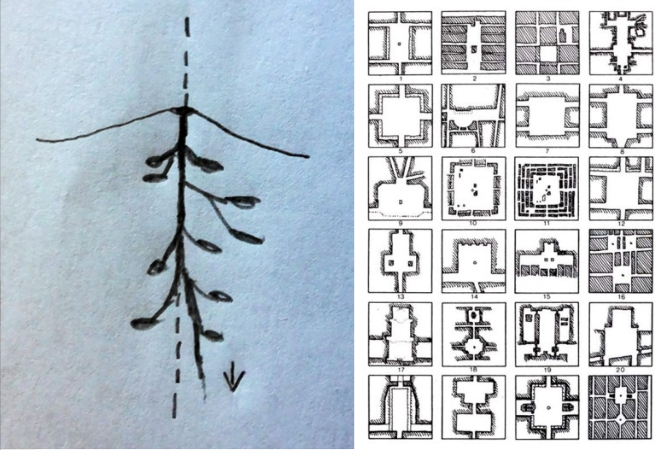Alexander Boys Smith applies the theory of Christopher Alexander’s pattern language to the architecture of Leafcutter Ants.
In 1977 the architect and theorist Christopher Alexander published his seminal work, A Pattern Language. It set out 253 “patterns”, physical ways in which humanity tends to solve the perennial problem of how to live alongside others in cities, towns, villages, neighbourhoods, streets or homes.

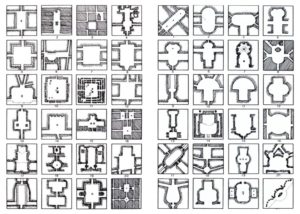
Christopher Alexander, ‘Patterns of rooms’ from ‘A Pattern Language’
Christopher Alexander’s patterns were his reaction against contemporary design and what he termed, “creating from nothing”. Instead he advocated following ideas that were evolved, intuitive and natural. Many urban designers and architects have been influenced by his work, for example new urbanism is based on the ideas of Leon Krier and Alexander. However, certainly until recently many more have not and he is absent from or tangential to most syllabi. If anything his influence has been greater on other forms of design most notably engineering, computer programming and even music. For Alexander, abstraction, or pointless design has become all too prevalent. His theory was intended to provide a sustainable solution to these problems.
Professor Alexander was very clear that the material he presented was A pattern language, not The Pattern Language for all time: his patterns were the ones he deemed most relevant at the time of writing. As he put it, “one possible pattern language.” And indeed in 2019 Michael Mehaffy, Yulia Kryazheva, Andrew Rudd and Nikos Salingaros published a new set of design patterns based on Alexander’s original ones. A New Pattern Language updated Alexander’s work, not modifying the original patterns but adding new ones with an enhanced focus on, for example, the importance of the natural kingdom within the urban realm, on insights derived from other species such as fractal design and on non-physical patterns of behaviour, regulation and communal or neighbourly organisation.
But could we go one step further and apply the concept of a pattern language to another species? I think we could because certain animals, above all some ants, bees and termites, fulfil certain relevant criteria. They are all ‘animal architects.’
-
- Firstly, they are sociable, living together.
-
- Secondly, they have complex needs requiring some form of coordination and cooperation (however instinctive).
-
- Thirdly, they possess a capacity to build complex structures to meet these needs some of whose purpose and even technology can be compared exhibiting similarities to human ones.
Some rodents, such as beavers, could also be argued to fulfil these criteria.
Animal architecture has been an intensely studied subject. From beaver dams to beehives, the practical qualities of these structures have been documented and evaluated with increasing specificity recently thanks to modern technology. For example, Mike Hansell’s 2005 overview of the subject, Animal Architecture, includes detailed examination of a spider’s web’s mechanical design and the organisation of a wasp nest. He does not, however, attempt to categorise animal architecture in terms of their natural patterns in the way that Christopher Alexander categorised human settlements.
Ants are among the most advanced eusocial organisms on the planet. (Eusocial means that animals work together to meet a common need in order to survive). The physical structures they make reflect this. In order to house their large colonies, most species dig nests. Some have hundreds of chambers and corridors. Colonies can range from a thousand individuals to eight million, about the population of London! Leafcutter Ant colonies are among the larger ones on the planet with an average of two million individuals per colony, about the population of Houston, Texas. Contrary to common belief, these ants do not eat the leaves they collect but rather break them down in order to grow fungus which they then eat. They are, in short, not hunters but farmers. They grow their food.
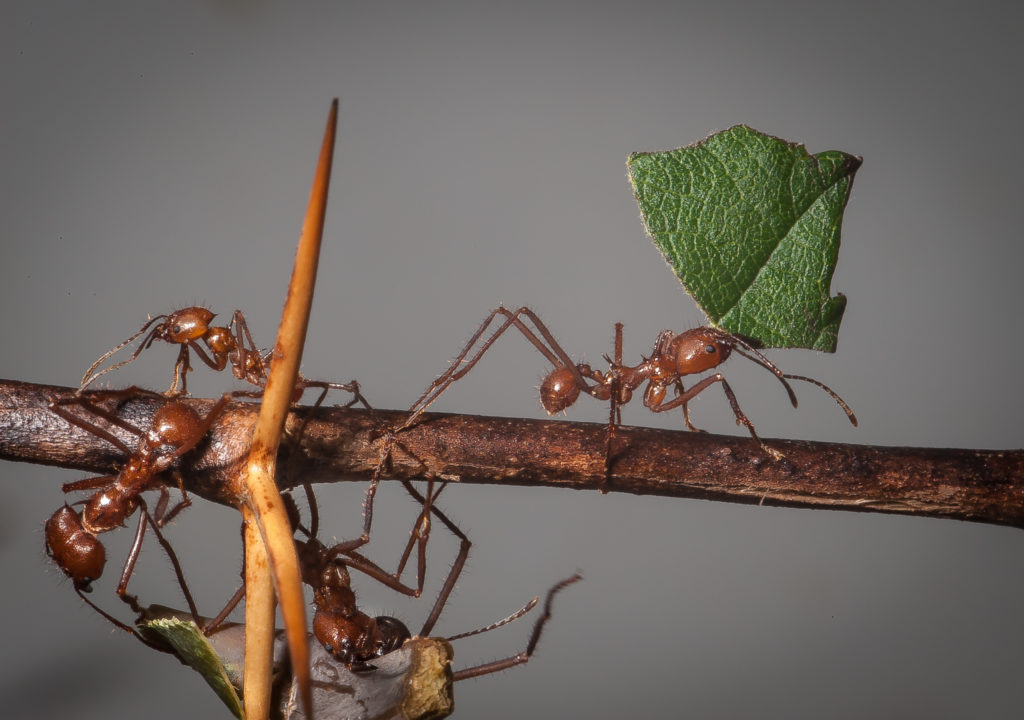
Atta cephalotes, Wilhelma Zoo, Stuttgart
I have chosen these ant species due to this agricultural, and therefore location-based, mode of living. Their needs go beyond the normal animal requirements of hunting or foraging. Above all, they cannot readily abandon their colonies. All their food is within. Due to this locational inflexibility, leafcutter ant nests require very good defensive capabilities. From movement to farming to defence, I suspect that a larger range of common patterns can be seen throughout the species group than for any other genus.
A pattern language for Leafcutter Ants would document core patterns visible in nests. These could range from location to individual structures present and would start at a large scale going down to micro-details. These patterns would, by definition, need to take into account the lifestyle of Leafcutter Ants and their requirements.
Following this logic my suggested twelve core patterns for leafcutter ants would be:
1. Right place beside a tree
2. Several metres deep
3. Nest with a middle
4. Symmetrical expansion
5. Root system
6. In-built ventilation
7. Deep farming galleries
8. Primary transport highways
9. Secondary tunnels
10. Defendable entrances
11. Omnidirectional junctions (Ants can climb on walls)
12. Mouldable materials (shiftable substrate which can be used to block entrances etc.)
Pattern 1: Right place beside a tree
First of all, the blindingly obvious, a tree is a very good source of fresh leaves. Due to the fact that most types of leaves are suitable for the ants’ purposes, this provides more flexibility. However, trees are not just a source of leaves. Ants’ nests spread out to such an extent that overstretching and physical collapse become a problem. To solve this, ants normally site their nests in firmer woodland earth making use of the tree’s roots holding the soil together. These support the many tunnels that the colony needs to aerate its fungus crops.
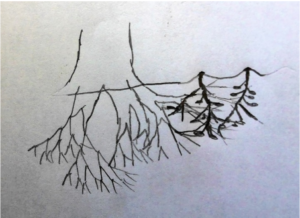
Leafcutter Ant colony situated beside a tree
Pattern 2: Several metres deep
Leafcutter Ant colonies can quickly expand. They need more space than other ants due to their fungal gardens. Therefore, rather than taking up space beside a colony, it is much more area-efficient to go deeper. Many colonies can dig down to five metres deep. The sheer size of these colonies can also protect to some extent from invasion. Even if a top portion is captured by an invading colony, passages can be blocked off and the attack weathered. Ants are not usually willing to lay siege.
Pattern 3: Nest with a middle
Colonies will usually be centred around a single vertical line. This is the first tunnel that the ant queen dug downwards to lay her eggs. It is from this that all the branching passageways will be dug out. This is visible in a developed ant colony. There is a clear epicentre from which all passageways branch out, showing the path of the first generation of workers hatched.
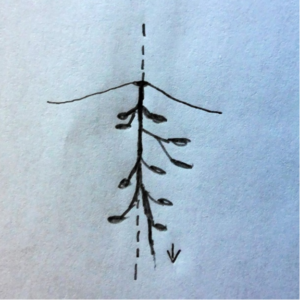
Leafcutter Ant colony with a single vertical line
Pattern 4: Symmetrical expansion
Just as in cities, having one extremely extended part of a colony is time-consuming. It just takes longer to get there and back and worker ants need to venture outside regularly. In order to reduce needless movement and the risk of neglect, all sides of the nest therefore grow out equally. In this way no part of the nest takes longer to reach and risks neglect due to the presence of fewer worker ants. Little visited parts of the colony would increase the risk of incursion or scavenging from other species.
Pattern 5: Root system
The nest, instead of forming itself into a messy web of tunnels instead branches out like a root system, in forks. Chambers branch off routes rather than being at the centre of a net of passages. In this way chambers do not become corridors and a steady flow of ants is present only present in the main passageways. This has been seen in many concrete, plaster or aluminium casts taken of nests.
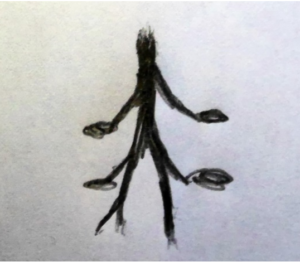
Leafcutter Ant root system with chambers branching off routes
Pattern 6: Ventilation systems
In Leafcutter Ant nests, some tunnels can be much wider than others. This is not so as to fit more ants but to provide ventilation. Leafcutter Ant colonies usually have several entrances within a certain vicinity of each other so that more air can circulate more easily. This is needed because of the ants’ farming habits because the fungus that they grow releases a lot of carbon dioxide. Sufficient ventilation is therefore needed so that the colony does not asphyxiate.
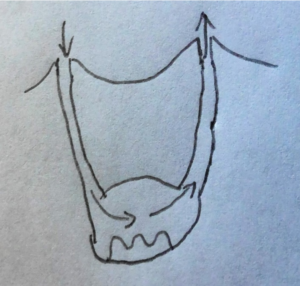
Ventilating the colony with natural air flow
Pattern 7: Deep farming galleries
The Leafcutter Ants’ only method of survival is agriculture, growing the Lepiotaceae fungus by fertilising it with leaves and plant litter. They do this in farming galleries. These chambers are usually some of the largest so that more fungus can be grown more efficiently, and so that air can circulate more freely. The galleries are normally situated fairly deep in the nest, so that any scavenging insects are not tempted to enter.
Pattern 8: Primary transport highways
In the nest, certain passages are longer and larger than others. These are the ants’ ‘main roads’ and perform a comparable role to human settlements. The primary routes that start from the nests’ entrances are used to transport materials (including food, leaves and larvae) as quickly as possible. If a network of small tunnels were the only option, the colony would slow down drastically. It is in these primary tunnels that a steady stream of ants travel to and from the surface.
Pattern 9: Secondary tunnels
Branching off from these large passages are secondary tunnels which lead to specific chambers. These are never connected directly to the surface. They are the equivalent of secondary roads or even cul-de-sacs.
Pattern 10: Defendable entrances
War is a very present part in the world of ants. Leafcutters Ants, having very large and complex nests are an attractive target for other ants. Leafcutters Ants therefore have to be able to defend themselves effectively. Leafcutter Ants are able to seal off entrances with earth to prevent incursion then mount a defence backed up by their formidable soldiers.
Pattern 11: Omnidirectional junctions
Ants, like many insects, are able to cling to walls and have made good use of this ability. Chamber entrances can be in any orientation, providing flexibility in nest construction and much more efficient use of space.
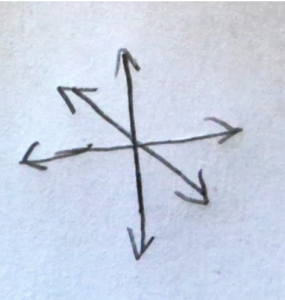
Omnidirectional junction
Pattern 12: Mouldable materials
Leafcutter Ant nest are dug into soft soil so that they can quickly be constructed. New chambers and passageways can rapidly be excavated and entrances blocked against invasion. This is a choice that is made directly by the queen, when she first selects where to dig into the ground to lay her eggs. The material cannot be too hard, otherwise a nest cannot grow., Nor can it be too soft as collapses would make nest construction impossible.
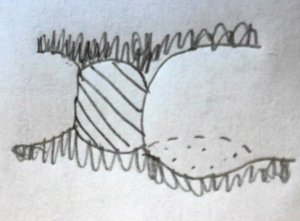
Shiftable substrate
Conclusion
Can the concept of a pattern language work for species other than humans? I think that it can. The patterns that Christopher Alexander and his colleagues set out in 1977 and which have been discussed and used ever since perhaps have three key criteria.
-
- They meet a physical, social or psychological need of humans living in family, village, town or city settlements.
-
- They are very frequently used and repeated (sometimes with variety for climate or culture or specific circumstances).
-
- They are modular and grow with their surroundings, not over them.
The patterns I observed in Leafcutter Ants appear to follow these criteria. Each pattern benefits the ant colony and its nest, meeting the ants’ needs and protecting them. In a Leafcutter Ant nest, repetition is frequent. Due to their, usually, large size the patterns listed above can be seen repeatedly throughout the nest, occurring hundreds or thousands of times just as in a human village, town or city. Although the Leafcutter Ant is considered an agricultural pest, the structures themselves do not interfere with their surrounding natural environments but coexist with them. The architecture of the Leafcutter Ant shows, I believe, that different species can instinctively possess and deploy the equivalent of a pattern language. If patterns can really be this flexible, the next questions becomes: what other species can be said to possess them?
Alexander Boys Smith is a student in England with a particular interest in insects and amphibians.


